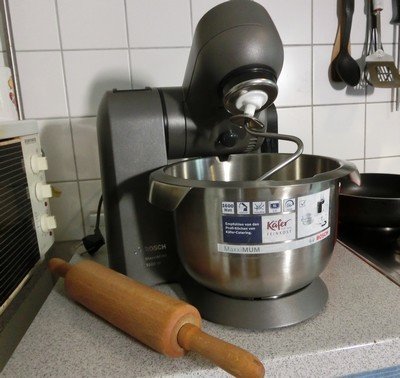
- Cuisine: East African
- Cuisine: East African
- Cuisine: East African
East African Chapati for Profis is a recipe that shows you basically how to make large quantities of East African Chapati, such as you would need for parties or for restaurants in relatively little time. It can be quite tiring kneading large amounts of the quite stiff dough, so we shall use a food processor. It is important to read the manufacturers instructions to determine the amount of dough you can mix in one go. We shall use a high performance & powerful Bosch MaxxiMUM, with a 5.4 liter stainless steel bowl, 1600W motor suitable for heavy bread doughs, to mix 2 kilograms of flour with 1 liter of water.
Ingredients
- 1 liter lukewarm water
- 2 kg plain white wheat flour (such as used for cakes & pastries)
- 2 teaspoons salt (heaped)
- 1 liter oil
- 200 grams onions (finely chopped/crushed. [Onions are optional!])
- For: 8 people
- Preparation: 15 min
- Cooking: 1 h
- Ready in: 1 h 15 min
Instructions
- To the flour in the dish, add 10 - 12 tablespoons of oil. Use the high performance hook to mix this at low speed.

- Add the finely chopped & crushed onions. (This step is optional)
- Mix 2 heaped teaspoons or slightly more of salt with the luke warm water
- Add the water to the flour and mix this at LOW speed. If well-kneaded, the dough should NOT stick to the sides of the bowel, unless too much water or probably the flour was not exactly the right type.

- In the meantime, prepare some big, clean board for kneading, and place a preferably teflon pan on some very hot plate.
- Remove the dough, which should be quite heavy (around 3 kg) and make some oblong shape out of it. Cut this into 2 with a knife, then halve each of the 2 pieces, then the 4, etc until you have a total of at least 16 pieces, i.e. 8 pieces /kg. You can off course make the chapatis a bit smaller, e.g. 12 / kg of flour.

- Make round shapes & cover the dough pieces you are not rolling yet with a piece of clean cloth or polythene to prevent them from drying. The oil added before helps prevent them sticking together, though you do not have to pile them together. If they do though, simply powder each with some flour ...
- Roll each piece to a roughly dinner-plate sized round shape. With the added oil & correct amount of water, they should not stick to the rolling board, but if so, powder the board with some flour.
- Carefully place the rolled chapati onto the now very hot pan. After a few moments with the chapati showing some dry patches, turn it over. Add about a teaspoon of oil to the top surface & use the spoon to quickly spread it over the surface. Quickly turn it over & repeat this for the other side. Turn it over if the oiled side shows brown patches, without getting burned (see pictures/video).
- To use the time efficiently, especially with so many chapatis to make, you will have to multitask & while the one chapati is in the pan, you roll the next, but not forgetting to check on its progress so it does not get scorched. At this speed, it should take about 1 - 1.5 hours to cook them.
Notes
 You can of course do without the food processor, but as you see it saves work by quickly doing the kneading. The consistency of the dough means you require some good bit of muscle-work to knead even 1 kg, let alone 2 at ago.
You can of course do without the food processor, but as you see it saves work by quickly doing the kneading. The consistency of the dough means you require some good bit of muscle-work to knead even 1 kg, let alone 2 at ago.
With the 8 chapatis/kg (16 for the 2 kg), the chapatis are big enough for most people 😉 to suffice for a complete meal with 2 per person, if nothing else, apart from the accompanying sauce is being served.
Chapati goes well with most meat and vegetable sauces. Cold chapati can be warmed up in an oven or a frying pan. Just make sure in the latter case, to turn them. You will note this makes them softer. Adding oil to the dough, like we do contributes to making them soft(!). Without this, the chapatis are harder.
Other chapati recipes on this site:
